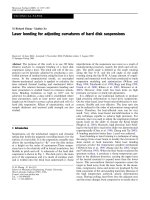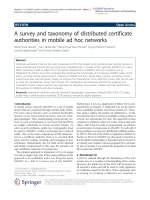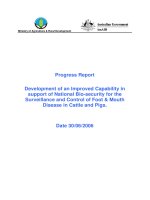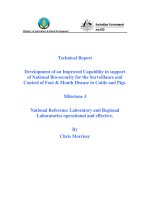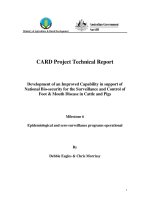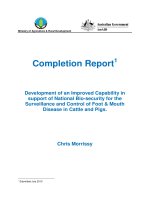Modeling and control of hard disk drive in mobile applications
Bạn đang xem bản rút gọn của tài liệu. Xem và tải ngay bản đầy đủ của tài liệu tại đây (1.19 MB, 130 trang )
Founded 1905
MODELING AND CONTROL OF HARD DISK DRIVE IN
MOBILE APPLICATIONS
PHYO PHYO SAN
(B.Eng. & M.Sc.)
A THESIS SUBMITTED
FOR THE DEGREE OF MASTER OF ENGINEERING
DEPARTMENT OF ELECTRICAL & COMPUTER ENGINEERING
NATIONAL UNIVERSITY OF SINGAPORE
2009
Acknowledgements
First of all, I would like to express my heartfelt appreciation to my supervisor, Professor Shuzhi Sam Ge, for his remarkable guidance to successfully complete this thesis
and giving me a chance to work on this research project.
I also would like express my sincere gratitude to my co-supervisor, Professor Tong
Heng Lee for his suggestions and remarks on many occasions that are extremely
helpful in improving my research work.
I am very grateful to Dr. Venkatakrishnan Venkataramanan who gave me guidance
into the field of disk drive servo technology and the efficient methodologies of research.
I would like to thanks to all my colleagues and friends in the Mechatronics and
Automation Lab and the Edutainment Robotics Lab for their concerns and help.
Special thanks to all the staff and students in the division of Mechatronics and Recording Channel in Data Storage Institute (DSI). Due to their great help, I have a chance
to learn the basics of disk drive servo systems and to set up the experimental platform.
Latest but not least, I wish to express my deepest appreciation to my family for their
understanding, encouragement and support throughout my studies.
ii
Contents
Contents
Acknowledgements
ii
Contents
iii
Summary
vii
List of Figures
x
Notation
xiv
1 Introduction
1
1.1
Disk Drive Technology Development Trend . . . . . . . . . . . . . . .
2
1.2
Overview of Hard Disk Drive System . . . . . . . . . . . . . . . . . .
4
1.3
HDD Servo System and Servo Control Challenges . . . . . . . . . . .
8
iii
Contents
1.4
1.3.1
Disturbance Rejection in HDD Servo System . . . . . . . . . .
13
1.3.2
Resonance Compensation in HDD Servo System . . . . . . . .
15
1.3.3
Friction Compensation in HDD Servo System . . . . . . . . .
17
Objectives, Scope and Structure of Thesis . . . . . . . . . . . . . . .
22
2 Preliminaries studies
26
2.1
Introduction . . . . . . . . . . . . . . . . . . . . . . . . . . . . . . . .
26
2.2
Friction Models and its Properties . . . . . . . . . . . . . . . . . . . .
27
2.2.1
Behavior of Static Friction Models
. . . . . . . . . . . . . . .
27
2.2.2
Behaviors of Dynamic Friction Models . . . . . . . . . . . . .
34
2.3
Choice of Nonlinear Friction Model . . . . . . . . . . . . . . . . . . .
39
2.4
Conclusion . . . . . . . . . . . . . . . . . . . . . . . . . . . . . . . . .
41
3 Mathematical Model of Hard Disk Drive Servo System
42
3.1
Introduction . . . . . . . . . . . . . . . . . . . . . . . . . . . . . . . .
42
3.2
Analytical Derivation of HDD Actuator . . . . . . . . . . . . . . . . .
43
3.2.1
Modeling of VCM actuator . . . . . . . . . . . . . . . . . . . .
43
3.2.2
Modeling of VCM actuator with a Current Driver . . . . . . .
46
iv
Contents
3.2.3
Analytical Obtained HDD Actuator Model with Resonances .
49
3.3
Frequency Domain IdentificationAlgorithm . . . . . . . . . . . . . . .
50
3.4
Conclusion . . . . . . . . . . . . . . . . . . . . . . . . . . . . . . . . .
53
4 Adaptive Neural Network Control Control Design
54
4.1
Introduction . . . . . . . . . . . . . . . . . . . . . . . . . . . . . . . .
54
4.2
Problem Formulation and Preliminaries . . . . . . . . . . . . . . . . .
56
4.2.1
Dynamics of Hard Disk Drive System . . . . . . . . . . . . . .
57
4.2.2
Function Approximation Using Radial Basis Function Neural
Network . . . . . . . . . . . . . . . . . . . . . . . . . . . . . .
59
4.3
Control Design and Stability Analysis . . . . . . . . . . . . . . . . . .
61
4.4
Simulation Studies . . . . . . . . . . . . . . . . . . . . . . . . . . . .
70
4.5
Conclusion . . . . . . . . . . . . . . . . . . . . . . . . . . . . . . . . .
71
5 Experimental Studies
75
5.1
Introduction . . . . . . . . . . . . . . . . . . . . . . . . . . . . . . . .
75
5.2
Experiment Setup . . . . . . . . . . . . . . . . . . . . . . . . . . . . .
76
5.3
Frequency-domain Identification of HDD Actuator . . . . . . . . . . .
80
v
Contents
5.4
Modeling of Pivot Friction Nonlinearity . . . . . . . . . . . . . . . . .
83
5.5
Experimental Results . . . . . . . . . . . . . . . . . . . . . . . . . . .
87
5.6
Conclusion . . . . . . . . . . . . . . . . . . . . . . . . . . . . . . . . .
89
6 Conclusion and Suggestion of Further Research
99
6.1
Conclusions . . . . . . . . . . . . . . . . . . . . . . . . . . . . . . . .
99
6.2
Recommendations for Further Research . . . . . . . . . . . . . . . . . 101
Bibliography
105
Author’s Publications
115
vi
Summary
Summary
The most important changes in hard disk drive (HDD) technology has been the rapid
increase in data storage density due to the rising demand in data storage systems.
High performance servo controllers are needed as data are accessed via the electromechanical voice-coil motor (VCM) actuator. Most of the servo systems use a VCM
actuator to actuate the read/write (R/W) recording arm assembly which consists of
a pivot with a ball bearing, a metal arm, and a rigid suspension that holds the R/W
head and slider.
To come up with devices that are smaller, cheaper and able to store more data and
retrieve them with faster speed, the presence of friction in the rotary actuator pivot
bearing becomes a more noticeable issues in the HDD industries. The pivot friction
hysteresis nonlinearity introduced by the bearing of the actuator pivot results in large
residual errors and high-frequency oscillations, which may produce larger positioning
error signal to hold back the further decreasing of the track width and to deteriorate
the performance of servo systems. Thus, it is highly desirable to characterize the
vii
Summary
behaviors of friction nonlinearities in the HDD servo systems. This thesis presents a
fairly comprehensive modeling and compensation of pivot friction hysteresis nonlinearity of a typical VCM actuator used in commercial HDDs and a practical account
of the application of an improved adaptive neural network (NN) controller to VCM
of HDDs.
In this thesis, a brief introduction of HDD servo technology and the prevalent trend
in hard disk design towards smaller hard disks with increasingly larger capacities are
presented. Followed by a brief overview of HDD head positioning servomechanism,
the fundamental components of an HDD servo system are introduced. A comprehensive studies of the commonly used classical friction models including both static
and dynamic models are presented for comparison and controller design. Besides, a
complete model of the VCM actuator including pivot friction hysteresis nonlinearity
is obtained through a careful examination of the configuration and structure of actual
system and through a thorough analysis of its physical effects in frequency domain
response.
In addition, a systematic treatment of adaptive neural network (NN) friction compensation techniques is presented from theoretical aspects in order to achieve high
precision motion control. By considering the position and velocity tracking control
of hard disk drive servo mechanism with friction, an improved adaptive NN friction
compensation is given based on the dynamic LuGre friction model. To achieve asymptotic tracking of the desired trajectory and guarantee the boundedness of all signals
viii
Summary
in the closed loop, an adaptive neural network (NN) control algorithm is designed by
the use of Lyapunov synthesis.
Finally, experimental studies is conducted with commercially available 3.5-inch hard
disk drive (Seagate Barracuda 7200.10), wherein the control objective is to track a
reference trajectory with the presence of hysteresis friction nonlinearity from the pivot
bearing. Extensive experimental results have shown that the proposed approaches
are effective for friction compensation in hard disk drive servo mechanism. Thus,
the conclusion is drawn by stating that the proposed adaptive NN control technique
has a feature of removing the uncompensated portion of friction nonlinearity without
sacrificing the overall tracking performance.
ix
List of Figures
List of Figures
1.1
Trend in HDD areal density (source: [1]) . . . . . . . . . . . . . . . .
3
1.2
Overview of hard disk drive system . . . . . . . . . . . . . . . . . . .
5
1.3
Typical servo loop in HDDs (source: [2]) . . . . . . . . . . . . . . . .
10
1.4
Track seeking and following of an HDD servo system (source:[2]) . . .
11
1.5
Frequency response of VCM actuator with resonance modes . . . . .
16
1.6
Pivot bearing in HDDs . . . . . . . . . . . . . . . . . . . . . . . . . .
19
2.1
Static friction models: Coulomb friction and coulomb plus viscous friction (source: [3]) . . . . . . . . . . . . . . . . . . . . . . . . . . . . .
2.2
30
Friction force as a function of displacement for Dahl’s model (source:
[3]) . . . . . . . . . . . . . . . . . . . . . . . . . . . . . . . . . . . . .
x
35
List of Figures
2.3
Frequency responses of VCM actuator with the influence of friction
nonlinearity . . . . . . . . . . . . . . . . . . . . . . . . . . . . . . . .
40
3.1
VCM actuator (source: [1])
. . . . . . . . . . . . . . . . . . . . . . .
44
3.2
The model of VCM actuator . . . . . . . . . . . . . . . . . . . . . . .
45
3.3
The model of VCM actuator with current driver . . . . . . . . . . . .
47
3.4
The model of VCM actuator with voltage driver . . . . . . . . . . . .
47
4.1
Overview of HDD with actuator assembly (source: [4]) . . . . . . . .
56
4.2
Block diagram of proposed friction compensator with neural network
62
4.3
Output tracking performance comparison . . . . . . . . . . . . . . . .
72
4.4
Control inputs comparison . . . . . . . . . . . . . . . . . . . . . . . .
72
4.5
NN weights norm W
. . . . . . . . . . . . . . . . . . . . . . . . . .
73
4.6
Estimated parameters trajectories . . . . . . . . . . . . . . . . . . . .
73
4.7
Tracking errors with different λ values . . . . . . . . . . . . . . . . .
74
5.1
Experimental setup . . . . . . . . . . . . . . . . . . . . . . . . . . . .
79
5.2
Schematic diagram for measurement of frequency response (source: [1]) 81
5.3
Frequency response of measured and identified HDD actuator model .
xi
82
List of Figures
5.4
Frequency responses of VCM actuator the influence of pivot friction
nonlinearity with different swept-sine input signal amplitudes at low
frequency range, 10Hz-200Hz . . . . . . . . . . . . . . . . . . . . . . .
5.5
Stimulated hysteresis friction curves given by LuGre friction model in
(4.1)-(4.4). . . . . . . . . . . . . . . . . . . . . . . . . . . . . . . . . .
5.6
91
Control input signal for the desired sinusoidal trajectory with A = 2
and f = 100 Hz . . . . . . . . . . . . . . . . . . . . . . . . . . . . . .
5.9
86
Tracking error for the desired sinusoidal trajectory with A = 2 and f
= 100 Hz . . . . . . . . . . . . . . . . . . . . . . . . . . . . . . . . .
5.8
86
Experimental pivot hysteresis friction nonlinearity curve at frequency
80Hz . . . . . . . . . . . . . . . . . . . . . . . . . . . . . . . . . . . .
5.7
85
91
Tracking error for the desired sinusoidal trajectory with A = 2 and f
= 200 Hz . . . . . . . . . . . . . . . . . . . . . . . . . . . . . . . . .
92
5.10 Control input signals for the desired sinusoidal trajectory with A = 2
and f = 200 Hz . . . . . . . . . . . . . . . . . . . . . . . . . . . . . .
92
5.11 Parameters adaptations for the desired sinusoidal trajectory with A =
2 and f = 100 Hz . . . . . . . . . . . . . . . . . . . . . . . . . . . . .
93
5.12 Parameters adaptations for the desired sinusoidal trajectory with A =
2 and f = 200 Hz . . . . . . . . . . . . . . . . . . . . . . . . . . . . .
xii
93
List of Figures
5.13 Step response with amplitude 0.5 µm . . . . . . . . . . . . . . . . . .
94
5.14 Control input signls for step response with amplitude 0.5 µm . . . . .
94
5.15 Step response with amplitude 5 µm . . . . . . . . . . . . . . . . . . .
95
5.16 Control input signal for step response with amplitude 5 µm . . . . . .
95
5.17 Parameters adaptations for step response with amplitude 0.5 µm . . .
96
5.18 Parameters adaptations for step response with amplitude 5 µm . . . .
96
5.19 Tracking error signals with different design parameter λ for the step
response with amplitude 5 µm . . . . . . . . . . . . . . . . . . . . . .
97
5.20 Tracking error signals with different design parameter λ for the sinusoidal respond with amplitude 2 µm . . . . . . . . . . . . . . . . . . .
97
5.21 Comparison results of experimental pivot hysteresis friction nonlinearity curves with and without friction compensation at frequency 80Hz
xiii
98
Notation
Notation
ADC
Analog-to-Digital Converter
DAC
Digital-to-Analog Converter
DSP
Digital Signal Processor
HDD
Hard Disk Drive
LDV
Laser Doppler Vibrometer
MEMS
Micro Electro-Mechanical System
NN
Neural Network
PD
Proportional Derivative
PES
Position Error Signal
PI
Proportional Integral
PID
Proportional Integral Derivative
TMR
Track Mis-Registration
TPI
Track Per Inch
VCM
Voice Coil Motor
xiv
Chapter 1
Introduction
The prevalent trend in hard disk design is towards smaller hard disks with increasingly
larger capacities. This implies that the track width to be smaller, which leads to lower
error tolerance in the positioning of the head. To meet with increasingly demand
in hard disk drives, the most important change in hard disk drive technology has
been carried out with an increase in data storage density. The HDD applications
are expected to be seen in digital camera, car navigation and audio systems, and
even mobile phones in the near future due to the ever increasing effort of HDDs
areal density. The servo system must achieve precise positioning of read-write head
(R/W) on a desired track (track following) and fast transition from one track to
another targeted track (track seeking) within shortest track seeking time for faster
data transmission rates.
In this chapter, some prevalent trends in the HDDs industry are examined in Section
1
1.1 Disk Drive Technology Development Trend
1.1. The basic knowledge about the HDD and HDD servo system are introduced in
Section 1.2. By discussing the recent research works in the track following control design for HDDs, the servo system and servo control challenges faced by servo engineers
and researchers are presented in Section 1.3. The rigorous analysis on the various
sources of disturbances, nonlinearities and uncertainties of a typical hard disk drive
servo system are discussed in Section 1.3.1, 1.3.2 and 1.3.3 respectively. In Section
1.4, the objectives, scopes and organization of thesis is presented.
1.1
Disk Drive Technology Development Trend
The hard disk drive (HDD) is the most preferred data storage device due to its low
cost, excellent scalability and the fact that it has highest areal density, largest capacity, highest transfer rate and highest access speed among data storage devices. With
the rapid progresses of magnetic recording technologies, the data storage areal density
of HDDs have been increasing dramatically through 1990’s. Commercial disk drive
areal density has reached approximately 120Gb/in2 in 2005 and expected to achieve
100Gb/in2 in 2009 under laboratory demonstration with possible commercialization
in 2013 [5]. As can be seen in Figure 1.1, the earliest hard disk drives supported an
real density of 2000bits/in2 . The increment in areal density has been achieved by a
factor of 5 million as presented in Figure 1.1. Track density has been increased by
reducing the off-track motion due to component disturbances and by improving the
2
1.1 Disk Drive Technology Development Trend
Figure 1.1: Trend in HDD areal density (source: [1])
ability of servo controller to regulate the head on narrower tracks.
The reduction on disk surface roughness, the quality of lubricant, the design of air
bearing play in improving storage bit density. Since those factors allow the slider
to fly in closer proximity of the disk, the bit size is reduced. In [6],[7], [8] and [9],
it has been discussed that the flying height in today hard disk drives are about 5
nanometers (nm) while typical flying height in 1997 were 25 (nm). In addition, the
data transfer rate has achieved more than 125M bits/s in today hard disk drives.
Since magnetic recording technology made continuous improvements in areal density,
size and form factors of HDDs, the reduction in disk size and form factors are also
significant in the evolutionary development of HDDs. Due to the diverse applications
3
1.2 Overview of Hard Disk Drive System
of HDDs in consumer electronics devices, today’s HDDs have form factors of 3.4”,
2.5” and even 1” in micro hard disk drives.
As technology advances, the significant reduction in disk size and form factors, increase in areal density and faster data transfer rate are highly desirable. With more
data being packed into a smaller space, servo positioning during data access operation
with the presence of larger amount of windage disturbances and other nonlinearities
become a challenge for HDD servo system.
1.2
Overview of Hard Disk Drive System
The HDD is a mechatronic system and it includes several components that can
be broadly classified into magnetic components, mechanical components, electromechanical components and electronics. In [1], it has been explained that the media
and the head are magnetic components of hard disk drive system and those are
assigned to be used in storage and retrieval of binary information. In HDD, the information is recorded and retrieved using the read/write head since the information
bits are stored in concentric data tracks on a rotating disk that is coated with magnetic media. Practical realization of such non-volatile storage and retrieval of binary
bits involves many other essential components such as a motor to spin the disks, an
actuator to make R/W head access the desired data etc. As presented in [2], the
essential components found in typical HDD can be clearly seen in Figure 1.2. The
4
1.2 Overview of Hard Disk Drive System
Figure 1.2: Overview of hard disk drive system
main functions and special features of those components are briefly explained in this
section.
Disk: A typical hard disk drive includes one or more flat rotating disks with two
magnetic surfaces that is called platters. The disk is mounted through a hole at the
center on the spindle of a motor for spinning of the disks. The data are recorded
on a continuously spinning disks which are made of aluminum or glass and coated
with a thin layer of magnetic material on both sides of a disk. To produce uniform
readback signal from the R/W heads that is flying a few nanometers above the disk
surface, the surface of the disk must be smooth. To ensure a very smooth surface, the
surface of each disk are precision machined and paid carefully attention to remove
any imperfections during the manufacturing process. However, the smooth disk drives
gives rise to a problem of producing stiction force when the R/W head touches the
disk surface if there is no disk rotation and no air bearing is formed. To solve the
5
1.2 Overview of Hard Disk Drive System
problem of stiction between head and disk, several methods have been proposed in
[10].
Head/Suspension Assembly: In HDDs, the R/W head are of ferrite, metal-ingap, thin-film or magnetoresistive (MR) types in which ferrite, metal-in-gap and thin
film types are used the principle of electromagnetic induction effect and that are
generally found in older types of R/W heads. In modern HDDs, the R/W head is
a thin-flim, metalized structure that exhibits magneto-resistive effect, in which the
resistivity changes when it is brought under the influence of a magnetic field. The
voltage across the MR sensor is obtained when a current flow through the MR head.
The voltage is a direct measurement of the magnetic field produced by binary bits
written on the disk surface. Both read and write operations in older disk drives were
performed by single head, while the modern HDDs use separated head for read and
write operations. These heads are referred to as a slider when those are positioned
only microinches above the recording medium on an air-bearing surface. A gimbal
attaches the slider to a suspension for pitch and roll rotations, while the suspension
is attached to the arm of the actuator by a ball swaging.
Actuator Assembly: In a hard disk drive system, a set of actuator assembly is
employed to position the read/write head on the certain track on the disk surface.
This actuator assembly consists of a VCM, data flex cable or printed circuit cable,
actuator arms and crash-stops at both ends of travel. The data are read/written
from/to the magnetic disk surfaces by the use of R/W heads mounted on the slider
6
1.2 Overview of Hard Disk Drive System
which is attached to the actuator arm. The function of actuator in HDD that is so
called VCM actuator is the same as a loud speaker. The coil of the VCM actuator
extends between a yoke/magnets. The VCM driver or amplifier are also part of
the actuator assembly which is mainly used to drive or give the power to the VCM
actuator.
Spindle and Motor Assembly: Brushless DC motor is responsible to spin the stack
of disks in HDD with stable, reliable and consistent turning power for thousands of
hours. All hard disks use servo-controlled DC spindle motor and are configured for
direct connection without the use of no belts or gears when it is connected to the
hard disk platter. The fluid dynamic bearing or aerodynamic bearing spindles are
normally used in high performance hard disk drives in which the spindle speed is
around 10,000 RPM or more. Many models of hard disk drives for the desktop and
mobile environment are still using the spindle speed of 5,400 RPM or 6,000 RPM
while high performance hard disk drives are using higher spinning rates such as 7,200
RPM, 10,000 RPM or even 15,000 RPM. The most critical component in hard disk’s
spindle motor is the set of spindle motor bearings at each end of the spindle shaft.
With the demand for higher areal density and faster spindle speed, the fluid dynamic
bearing (FDB) spindle motor are adopted in HDDs. In ball bearing motors, it is
impossible to make the ball and race of the bearings perfect and free from the defects
due to the existence of mechanical contact between the ball and race of the bearing.
In addition, the variation in spindle speed is a major source of disturbance in the
7
1.3 HDD Servo System and Servo Control Challenges
tracking servo loop and the speed of the motors must be precisely controlled.
Electronic Card: The electronic card behave as an interface to the host personal
computer. The widely used integrated electronic circuit in hard disk drives are the
Integrated Drive Electronics (IDE), the Advanced Technology Attachment (ATA),
and the Small Computer System Interface (SCSI). These integrated circuits have
a power driver for the spindle motor, VCM, R/W electronics, servo demodulator,
microcontroller or digital signal processor (DSP) for servo control, ROM and RAM
for microcode and data transfer.
Device Encloser: This is the most important component in hard disk drives because
it determines the reliability of the disk drives and helps to keep the contamination
low. It also keeps out dust and other contamination that are harmful to the R/W
heads and the platters with the aid of recirculation and a breather filter. By doing
so, the possibility of head crashes are also reduced. A gasket is used a seal between
the top cover and the base casting that provides supports for the spindle, actuator,
VCM yoke and electronics card.
1.3
HDD Servo System and Servo Control Challenges
A servomechanism or servo is a control system which has the specific task in controlling the position and velocity of a mechanical plant in which the actuator is responsible
for the actual motion. In direct access storage devices, the servomechanism is called
8
1.3 HDD Servo System and Servo Control Challenges
the head-positioning servomechanism (HPS) as shown in Figure 1.3. In a hard disk
drive system, head positioning servomechanism is a system to control the R/W heads
of a disk drive to move from one track to another track or to follow the desired track
[11].
The two major functions of head positioning servo mechanisms are track seeking and
track following, which have two basic problems of servo control. The head positioning servomechanism moves the R/W head as fast as possible from one track to
another when asked by the host system (Track Seeking). Once the head reaches the
target track, it is regulated precisely over the track so that the PES is minimized
(Track Following). Another important feature expected in HDD servomechanism is
the smooth settling while the transition occur between the track seeking and track
following modes without any jerk. The detailed description of servo modes in an
HDD has been clearly explained in [2] as shown in Figure 1.4.
The nature of track seeking control is to force the actuator angular velocity to follow
an ideal angular velocity profile that will guarantee the shortest possible seek time
with minimum jerk. The data access time during read/wite head operation will be reduced due to fast seeking. The smooth seeking would yield less acoustic noise to have
better performance of HDD in consumer electronic appliances. When the actuator
is less than one track pitch away from the target track, the settling mode takes over
from the seeking to following mode. In the HDD servo design, two different types
of controllers are used for track-seeking and track-following. The mode switching
9
1.3 HDD Servo System and Servo Control Challenges
Figure 1.3: Typical servo loop in HDDs (source: [2])
control is usually adopted in the transient process so that the center of the recording
head is kept within a certain position error tolerance of the target track center line
for a fast control mode switching. Usually a control system is designed under the
assumption that the initial vales are zero. However, in this case, the initial states of
the track-following mode cannot be ignored since the ”initial” means a time at mode
switching and state variables such as velocity and position may have non-zero values.
Those initial states may cause undesirable settling response if not being compensated.
In [12], a nonlinear feedback control with time-varying damping factor was proposed
for better settling response.
In the track following mode, the servo objective is to stay as close to the track center
line as possible while reading and writing information. The control objective of HDD
10
1.3 HDD Servo System and Servo Control Challenges
Figure 1.4: Track seeking and following of an HDD servo system (source:[2])
track-following control is to track a desired trajectory, where the desired output can
be treated as a known signal and the actual output can be measured to use as a
feedback signal in control algorithm. On the other hand, the HDD track-following
controller must be able to compensate in Position Error Signal (PES), which is the
difference between the desired track position and the actual head position. In the
track-following control, the actuator saturation is not explicitly considered and the
feedback controller is designed primarily based on linear control theory for stability
such as PID (Proportional Integral Derivative) and lead-leg compensator. These
feedback controllers are not enough for accurate positioning due to the presence of
various disturbance sources, noise and other nonlinearities exist in the servo channel.
In [13], it has been presented that the performance of positioning is evaluated by
11



